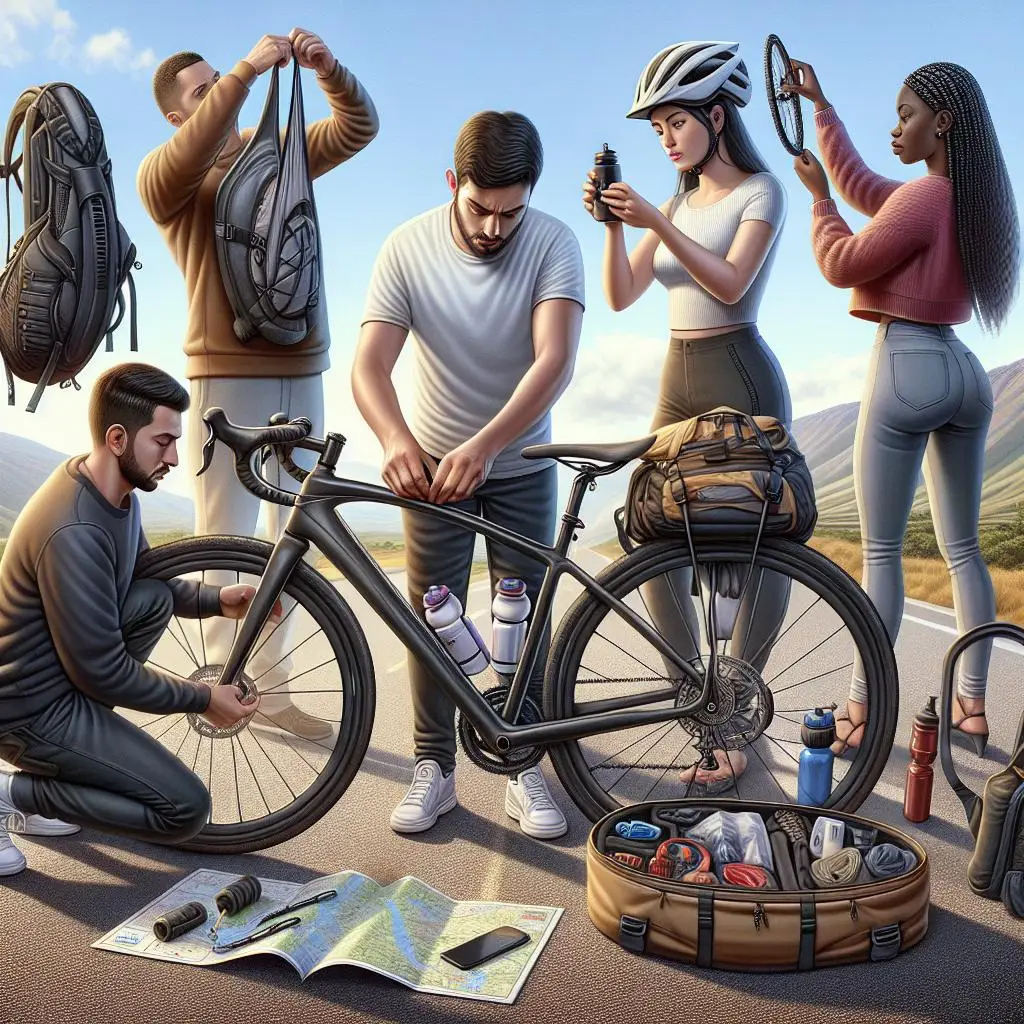Bike travel tips are most powerful when they combine practical planning with on-the-road wisdom earned from many miles, and that’s the perspective I bring after guiding riders across continents and coaching first-time tourers. The secret is balancing ambition with realism so that every day’s route, budget, and effort level fit your current fitness and skills. Treat your bike as both vehicle and companion, because how you maintain and pack it determines whether your trip feels liberating or punishing. With the right cycling advice, even small choices—like tire pressure, start times, and snack strategy—add up to big confidence on unfamiliar roads.
Before you pick a destination, define what success looks like for you, whether that’s a personal best distance, a cultural deep dive, or simply finishing every stage smiling, and then translate that into daily mileage that leaves time for detours. Map three route options for each day—a scenic plan A, a pragmatic plan B, and a bailout plan C—so weather or fatigue never forces bad decisions.
If you’ve been skimming lists of bike travel tips online, remember that templates are only starting points and your trip should be tailored to your body, your calendar, and your curiosity. Anchor your plan with realistic stop points for water, food, and sleep, and you’ll remove most sources of stress before they start.
Packing light is art and safety protocol in one, and it starts by choosing gear for bikers that prioritizes durability, visibility, and fast repairs over flashy novelty. Build your kit around the terrain: wider tires for mixed surfaces, a compact gearing range for climbs you might meet late in the day, and a saddle you’ve already tested for at least two weeks of rides.
Clothing layers should work across a ten-degree temperature swing without constant changes, and a small laundry routine every two or three days keeps your load sane. A complete repair roll—multi-tool with chain breaker, two spare tubes or plugs, patches, a spare master link, and a pair of nitrile gloves—beats any rescue story every time.
Fitness for touring is different from racing, because you need repeatable strength rather than single-day heroics, and that changes your training emphasis. Build aerobic endurance with back-to-back medium rides on weekends to simulate fatigue, and add two short sessions of strength and mobility each week to protect your back, hips, and hands on long hours in the saddle.
A professional bike fit solves more problems than new components, from numb fingers to stubborn knee niggles, and is worth scheduling a month before departure so you can adapt. Sprinkle in technique-focused rides—cornering, braking, and cadence drills—because precise control is underrated cycling advice that directly reduces risk.
Fueling decisions decide how you feel at mile 60, so eat early and often with a mix of slow-release carbs, modest protein, and salt, and hydrate proactively rather than reactively. I coach riders to set a quiet thirty-minute timer that cues a bite or a sip, because your appetite will lag behind effort when scenery distracts you.
Carry a “rescue ration” you never touch unless a store is closed or a hill is longer than the map suggests, and restock it at the first opportunity. In heat or at altitude, plan for extra sodium and a third bottle, and if you’re unsure about gut tolerance, test everything during training, not on day one of your tour.
Road awareness should be your default posture, and that starts with conspicuity: day-running lights front and rear, high-contrast clothing, and a reflective ankle band that draws a driver’s eye to your movement. Learn local traffic norms before you roll; in some regions drivers expect you to take the lane, in others they anticipate a shoulder-hugging line, and your safety depends on matching those expectations.
If you’ve been searching “travel tips bike” for urban riding, add one more rule: assume you’re invisible at junctions and make deliberate, unmistakable gestures. Have a simple emergency plan—who to call, how to share your location, and a printed card with any medical details—to turn a crisis into logistics rather than panic.
Navigation should be layered: a primary GPS route, offline maps on your phone, and a compact paper map for context when electronics fail or rain clouds scramble touchscreens. Power is its own system, so pair efficient screen use with a small cache battery, and consider a dynamo hub for longer expeditions where wall sockets are rare.
Train yourself to read the land—rivers, ridgelines, wind direction—so you can make smarter choices when detours appear or surfaces change, and keep an eye on sunset times to avoid unplanned night riding. When you build habits like these into your daily routine, Bike travel tips stop being theory and start becoming muscle memory.
Planning and finance: Bike travel tips for real life

Your budget lives in the details, so estimate costs by category—sleep, food, transport, spares, and surprises—and then add a buffer for the unknowns that inevitably appear on human-powered adventures. Long before departure, practice your daily spend at home to find a sustainable rhythm of café stops, groceries, and occasional splurges, which prevents overshooting early and rationing later.
Treat road trip preparation like risk management by identifying the top five likely expenses you can control—lodging type, route shape, rest days, mechanicals, and data connectivity—and then pre-deciding how you’ll act when each shows up. This kind of clarity reduces decision fatigue and keeps morale high when the weather or your legs underperform.
Transport logistics can make or break your first day, so study bike policies for airlines, trains, and buses, and choose cases or bags that fit rules without fuss. Practice packing your bike twice before the real thing, taking photos of cable routing and cockpit layout so reassembly is quick even after a red-eye flight, and cushion derailleur hangers and brake rotors like they’re made of glass.
Consider travel insurance that explicitly covers bicycles and your intended distances, and store digital copies of serial numbers, receipts, and fit measurements in the cloud. When you share Bike travel tips with friends, emphasize that smooth transfers protect both schedule and stoke, and they’re worth every minute of prep.
Crossing borders adds a layer of admin that’s easier to handle when you do the homework early and keep it tidy. Verify visa and vaccination requirements through official channels, and note entry limitations on food or tools that might affect your packing list. Keep a small folder or pouch for documents, with printouts of reservations, emergency contacts, and a paper map to show someone if language barriers arise. For longer trips, decide how you’ll handle banking, roaming, and backups of photos and routes, because losing data is more demoralizing than losing a multitool.
Weather is the variable everyone underestimates, so design flexible itineraries that let you swap a mountain pass day after a storm cycle or slide a rest day forward when heat spikes. Study seasonal patterns and local microclimates, and remember that wind can steal more energy than hills, so align longer days with tailwind forecasts when possible. Your kit should reflect the rule of threes: three ways to stay warm (insulation, movement, food), three ways to stay dry (shell, fenders, timing), and three ways to be seen (lights, reflectives, lane position). Strategic layering is not just comfort; it’s resilience in motion.
Cultural fluency pays dividends, because the road is a string of human interactions that shape your safety and joy. Learn a handful of phrases for greetings, gratitude, and directions, and keep your tone open and patient at shops and checkpoints.
Ask about water availability and local closures at cafés and markets; these conversations often surface unmarked road works, detours, or seasonal closures a map won’t show. When riders swap bike travel tips at hostels or campgrounds, the best nuggets are usually social—where cyclists are welcomed, when dogs are feisty, and which bakery opens before sunrise.
If you plan to work remotely, test your workflow in advance with a “tour simulation week” at home, riding mornings and working afternoons, to refine charging strategy, hotspot coverage, and focus rituals. Set non-negotiable boundaries on meeting times and daily mileage so neither side cannibalizes the other, and remember that your brain needs a different gear after five hours of beautiful fatigue.
For content creators, define a simple capture routine—one photo per hour, one thirty-second video per day, one paragraph of notes before sleep—so storytelling enhances the ride rather than consuming it. This is where essential tips for bike travel overlap with time management, because sustainable habits beat sporadic heroics.
Finally, think like a publisher when it comes to memories: organize files nightly, tag locations, and jot down names of people who helped you, since gratitude posts are better with details. Share route feedback with local cycling clubs and shops to give back to the communities that supported your rolling project. If you accept gear or route suggestions from sponsors or friends, log what worked and what didn’t, and be candid in your debrief so others benefit from your experience. A little structure turns anecdotes into useful guidance others can trust.
Packing and maintenance: essential tips for bike travel
Start every morning with the same five-minute ritual: check tire pressure with a small gauge, spin wheels to spot cuts or lodged debris, squeeze brakes, shift through gears, and scan for loose bolts. Wipe and lube the chain only when it’s needed, not on a fixed schedule, because over-lubing invites grit and undercuts efficiency on dusty roads.
Carry spares that match your bike’s standards—derailleur hanger, spare cleat bolts, a short section of chain—and keep them in the same pocket every day so muscle memory finds them under stress. This is where gear for bikers becomes about systems, not souvenirs, because predictability is your best tool in a headwind or a drizzle.
Pacing is your invisible superpower, and the simplest way to master it is to ride the first hour of every day easier than you feel, especially after rest days when legs can feel deceptively fresh. Break the day into thirds: settle in during the first, hold rhythm during the second, and budget extra time for photos, food, and flats during the third.
Most setbacks cluster late in the day, so road trip preparation includes a policy of not chasing lost minutes in traffic or weather; instead, shorten the stage or move a sightseeing stop to tomorrow. When you protect the end of your day, you protect tomorrow’s start.
If you’re riding in a group, assign light roles—navigator, mechanical lead, timekeeper—that rotate daily to prevent fatigue and sharpen shared awareness. Agree on a communication protocol for hazards and regroup points, and keep stops purposeful by deciding in advance what gets done at each pause.
The best cycling advice for groups is to honor each rider’s “red lines” on risk and comfort, which might include night riding, traffic density, or unpaved detours, and to discuss them before they’re tested. Groups amplify both joy and stress, and clarity keeps the ratio in your favor.
When things go sideways—and they will—start by slowing down your thinking so you can diagnose rather than react. Fix what’s fixable where you stand, whether that’s a slow puncture, a wobbly rotor, or a creaking seatpost, and relocate only if safety demands it; moving while flustered often creates new problems.
If you crash, prioritize people over bikes, check for head injury signs, and use a basic first-aid script before you assess the machine, documenting any damage for later claims. In debriefs where I share Bike travel tips, I always remind riders that poise is a skill you can practice on small annoyances long before high-stakes moments.
Sustainability strengthens itineraries, because the less waste you generate the lighter your conscience and your bags. Refill bottles whenever possible, carry a compact filter when sources are uncertain, and choose bulk snacks over single wrappers when shops allow it.
Respect local land use, close gates behind you, and camp only where permitted, keeping a low visual and noise footprint that earns cyclists a welcome in the next valley. Spend money locally, thank people by name, and remember that your route becomes easier for future riders when you’re a courteous guest today.
Mental game matters as much as quads, so build rituals that reset mood when weather sours or fatigue whispers that you miscalculated. A short walk without the bike, a warm drink, or a ten-minute stretch can reset your outlook before you make route changes you might regret, and so can a call to a friend who understands your goals.
If you set expectations by hour rather than by mile—“I ride until noon, reassess, and decide”—you’ll feel more control on days when headwinds erase distance. Dismiss any rigid formula you saw under “travel tips bike” and draft your own playbook based on how your motivation actually behaves.
As you gain experience, your standards will rise: you’ll refine packing lists, swap tires for the surfaces you truly ride, and learn which cafés top off bottles without a purchase and which towns nap after lunch. Log these discoveries in a simple spreadsheet or notebook, and keep a “next-trip” list that prevents repeating small mistakes like forgetting a spare valve core or not marking your saddle height.
Share a few Bike travel tips with newer riders when you cross paths, because teaching locks in your own learning. Most of all, protect your love of the road by ending trips with a day you could happily ride again tomorrow, leaving appetite in the tank for the next adventure.
Cycling has steadily grown from a simple mode of transportation into a lifestyle choice, a sport, and even a way of connecting with nature. Across cities and rural landscapes alike, bicycles represent independence, sustainability, and health. When people look for cycling advice, what they truly seek is not a set of rigid rules but a framework to enjoy the journey, stay safe, and make the most of every ride. At its core, riding a bike combines physical endurance with mental clarity, giving riders a sense of freedom that few other activities can match.
One of the most important aspects of building a cycling habit is preparation. A rider who sets out without considering the basics—hydration, clothing, and route planning—often finds that the smallest details can shape the entire experience. Wearing weather-appropriate layers, checking tire pressure, and carrying a small repair kit may seem minor at first, but they transform casual outings into reliable, enjoyable sessions. This type of foresight ensures that whether you’re commuting to work or exploring new trails, the ride remains smooth and less stressful.
Beyond the technical side, cycling is deeply tied to wellness. Studies consistently highlight how moderate daily rides improve cardiovascular health, strengthen muscles, and enhance lung capacity. Yet the psychological rewards are just as significant. Many riders describe the meditative rhythm of pedaling as a reset button for the mind. The steady pace, combined with open air and changing scenery, can dissolve stress more effectively than many other fitness routines. In this sense, those searching for cycling advice are often tapping into a desire for balance between body and mind.
Community is another powerful element of the cycling world. Local clubs, online forums, and organized tours create opportunities for riders to share experiences and learn from one another. Beginners often feel intimidated by more seasoned cyclists, but the truth is that most communities are built on support and encouragement. Group rides, for instance, not only enhance motivation but also introduce safety benefits by making cyclists more visible on the road. Advice shared within these circles goes far beyond equipment or training—it creates a culture of belonging that keeps riders engaged for years.
Nutrition and recovery also play a major role in sustaining long-term enthusiasm. A balanced diet, rich in complex carbohydrates, lean proteins, and healthy fats, fuels muscles effectively for long distances. Just as critical is post-ride recovery: stretching, hydration, and adequate rest. Ignoring these elements leads to burnout and injuries, while respecting them helps maintain consistent progress. Simple guidance in this area often proves to be the most transformative cycling advice of all, because it bridges the gap between ambition and sustainability.
Technology has reshaped the cycling experience in ways that previous generations could scarcely imagine. GPS navigation, performance tracking apps, and smart trainers allow riders to measure progress, analyze efficiency, and push personal limits with unprecedented precision. At the same time, these tools remind us that cycling remains a fundamentally human experience—no device can replicate the sensation of wind rushing past on an open road. Technology, then, should be seen as a companion, not a replacement, to the raw joy of riding.
Finally, the broader cultural and environmental role of cycling cannot be ignored. In many cities, bicycles are central to sustainable transport strategies, reducing congestion and lowering carbon footprints. Riders who choose the bike over the car are not only investing in personal health but also contributing to healthier communities and cleaner air. This connection between individual choice and collective benefit makes cycling a uniquely powerful activity, one that blends leisure, sport, and civic responsibility.
When all of these elements—preparation, wellness, community, nutrition, technology, and sustainability—come together, the result is more than a pastime. It becomes a lifelong practice that nurtures both the self and society. That is why even the simplest piece of cycling advice carries weight: it speaks to an ongoing journey of growth, discovery, and freedom.













